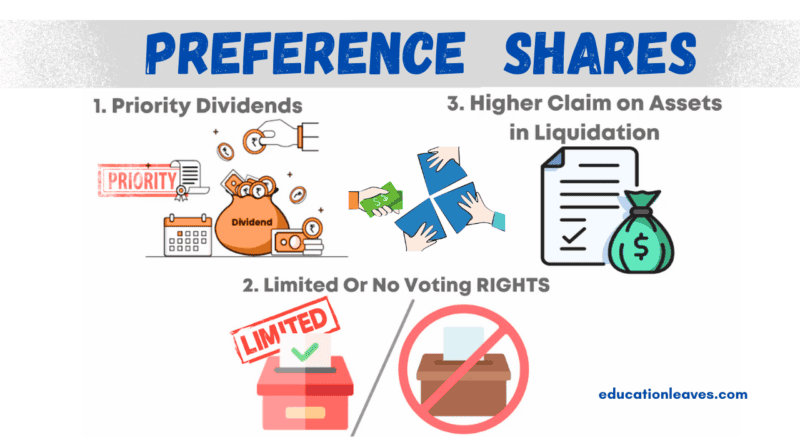What are the Preference Shares or Preferred Stock? Advantages and disadvantages, Features, Similarities and Differences
In the world of investing, companies can raise capital by issuing different types of shares. The two most common types are common stock and preference shares, also known as preferred stock. This part will introduce you to preference shares, explaining what they are, how they differ from common stock, and the pros and cons of including them in your investment portfolio.
What you are going to learn?
What are Preference Shares?
Think of preference shares as a special class of stock that grants investors certain privileges over common stockholders. The key benefit lies in dividends. Preference shareholders have the right to receive dividend payouts before any dividends are distributed to common shareholders. These dividends are typically fixed, meaning they represent a set percentage of the face value of the share.
Here’s an analogy: Imagine a company as a pie. Common shareholders are like guests who get a slice of pie after everyone else has been served. Preference shareholders, on the other hand, are seated at the head table and get their slice first.
Why Choose Preference Shares over Common Stock?
Investors who seek predictable income might find preference shares appealing. The fixed dividend provides a reliable stream of income, similar to a bond. Additionally, in the event of company liquidation, preference shareholders have priority over common shareholders in claiming their share of the remaining assets (after debts are settled).
Downsides of Preference Shares
While preference shares offer some advantages, they also come with limitations. Unlike common shareholders, preference shareholders typically have no voting rights. This means they have no say in the company’s direction or decision-making. Additionally, the fixed dividend nature of preference shares means they might not experience the same level of capital appreciation (growth in share price) as common stock, especially during periods of strong company performance.
Dividend Rights of Preference Shares
As we saw previously preference shares are all about prioritized dividends. This part will dissect the different aspects of dividend rights associated with preference shares, giving you a clearer understanding of how these payouts work.
Fixed vs. Variable Dividends
- Fixed Dividends: The most common type of preference share offers a fixed dividend. This means the company pays a predetermined amount per share, usually expressed as a percentage of the face value. For example, a 5% preference share with a face value of ₹100 would entitle the holder to a fixed dividend of ₹5 per year.
- Variable Dividends: Less prevalent are preference shares with variable dividends. These dividends fluctuate based on the company’s performance. However, there’s usually a minimum guaranteed amount specified.
Cumulative vs. Non-Cumulative Dividends
This distinction relates to what happens when a company withholds dividends on preference shares.
- Cumulative Preference Shares: Here, if the company decides not to pay dividends in a particular year, the arrears (unpaid dividends) accumulate. These arrears must be paid in full to preference shareholders before any dividends are distributed to common shareholders in subsequent years.
- Non-Cumulative Preference Shares: If dividends are skipped on non-cumulative preference shares, the forfeited amount is simply gone. The shareholders have no right to claim it in the future.
Priority over Common Stockholders
One of the key advantages of preference shares is the priority given to their dividend payouts. As mentioned earlier, preference shareholders must receive their full dividend allocation before any dividends are distributed to common shareholders. This preferential treatment provides a level of security for income-seeking investors.
Important Note: It’s crucial to remember that companies are not obligated to pay dividends, even on preference shares. However, if they choose to distribute dividends, preference shareholders get theirs first.
Voting Rights and Other Considerations in Preference Shares
Now that we’ve covered the preferential treatment regarding dividends, let’s explore other key aspects of preference shares, including voting rights and some additional features.
Limited Voting Rights or No Voting Rights at All
One of the significant drawbacks of preference shares is their limited or non-existent voting rights. Unlike common shareholders who have a say in company decisions by voting on resolutions at shareholder meetings, preference shareholders typically have no voting rights or very limited voting rights in specific circumstances. This translates to less control over the company’s direction and management.
Convertible Preference Shares
Some preference shares offer a conversion feature. This allows investors to convert their preference shares into a predetermined number of common shares at a specific time or under certain conditions. This feature can be attractive if you believe the company has strong growth potential and you want to participate in future capital appreciation alongside the fixed dividends.
Redeemable Preference Shares
Redeemable preference shares give the company the option to buy back the shares from investors at a predetermined price on a specific date or after a certain period. This allows the company to manage its capital structure and potentially reduce its dividend obligations in the future.
Liquidation Preference
In the unfortunate event of a company liquidation (closure and sale of assets), preference shareholders generally have liquidation preference over common shareholders. This means they get priority in claiming their share of the remaining company assets after debts are settled. However, the extent of this preference can vary depending on the specific terms of the preference shares.
Other Considerations
While not as common, some preference shares might have additional features like participating dividends. These allow preference shareholders to receive additional dividends beyond their fixed amount if the company’s profits exceed a certain threshold.
Unveiling the Different Types of Preference Shares
The world of preference shares extends beyond a single type. This part will introduce you to the various classifications of preference shares, highlighting their unique features to help you choose the ones that best suit your investment goals.
1. Cumulative vs. Non-Cumulative Preference Shares
We briefly touched upon these in Part 2, but let’s revisit them for clarity.
- Cumulative Preference Shares: Remember, these shares accumulate unpaid dividends (arrears) if the company skips a dividend payout. These arrears must be settled in full before common shareholders receive any dividends.
- Non-Cumulative Preference Shares: With these shares, any missed dividends are simply lost. They do not accumulate for future payout.
2. Fixed vs. Variable Rate Preference Shares
As discussed earlier:
- Fixed Rate Preference Shares: These offer a predetermined, fixed dividend amount per share, usually expressed as a percentage of the face value.
- Variable Rate Preference Shares: Less common, these shares offer dividends that fluctuate based on the company’s performance, though often with a minimum guaranteed amount.
3. Convertible Preference Shares
These shares provide the flexibility to convert them into a predetermined number of common shares at a specific time or under certain conditions. This allows you to potentially benefit from future capital appreciation of the company’s stock price alongside the fixed dividends.
4. Redeemable Preference Shares
These shares grant the company the option to repurchase them from investors at a predetermined price on a specific date or after a certain period. This allows the company to manage its capital structure and potentially reduce its dividend obligations in the future.
5. Participating Preference Shares
These are less frequent but offer the potential for additional dividends beyond the fixed amount. They allow preference shareholders to participate in the company’s prosperity if profits exceed a certain threshold.
6. Non-Participating Preference Shares
These are the standard preference shares that only receive their fixed dividend, regardless of the company’s profits.
Choosing the Right Preference Share
The ideal preference share for you depends on your investment goals. If you prioritize a steady income stream, cumulative fixed-rate preference shares might be suitable. If you believe the company has growth potential and want some capital appreciation alongside dividends, convertible preference shares could be attractive.
Remember: Carefully research the specific features of each preference share offering before investing.
Who Should Invest in Preference Shares? – Finding the Right Fit
Now that we’ve explored the mechanics and various types of preference shares, it’s time to consider who might find them a good fit for their investment portfolio. Here, we’ll delve into the ideal investor profile for preference shares.
Target Investors for Preference Shares
- Income-Seekers: If you prioritize generating a steady stream of income from your investments, preference shares can be a compelling option. The fixed or minimum guaranteed dividends provide a predictable source of income, similar to bonds.
- Risk-Averse Investors: Compared to common stock, preference shares offer a layer of security. The priority given to dividend payouts and liquidation preference can be appealing to investors with a lower risk tolerance.
- Investors Seeking Portfolio Diversification: Preference shares can add diversification to your portfolio. They offer characteristics that fall somewhere between stocks and bonds, potentially reducing overall portfolio volatility.
Who Might Want to Look Elsewhere?
- Growth-Oriented Investors: If your primary goal is capital appreciation, preference shares might not be the best choice. Their fixed dividend structure limits their potential for significant growth in share price compared to common stock.
- Investors Who Value Voting Rights: Since preference shareholders typically have limited or no voting rights, they have less influence on company decisions. This might be a drawback for investors who value active participation in the companies they invest in.
- Investors Seeking High Liquidity: Preference shares are generally less liquid than common stock. This means they might be harder to buy and sell quickly, especially for lesser-known companies.
Important Considerations
- Creditworthiness of the Issuing Company: As with any investment, consider the financial health of the company issuing the preference shares. A company’s ability to consistently pay dividends is crucial.
- Call Provisions: Some redeemable preference shares have call provisions. This allows the company to redeem the shares at a predetermined price before the maturity date. This can be disruptive if you were hoping to hold them until maturity.
Preference Shares – A Hybrid Investment for a Balanced Portfolio
We’ve reached the final chapter of our exploration into preference shares. Here, we’ll summarize the key takeaways and solidify their role within an investment strategy.
Recap: The Allure of Preference Shares
Preference shares offer a unique blend of features, making them a hybrid security between stocks and bonds. They provide investors with:
- Predictable Income: The fixed or minimum guaranteed dividends offer a reliable stream of income, similar to bonds.
- Priority Over Common Shareholders: Preference shareholders receive dividends and have a claim on assets before common shareholders in case of liquidation.
- Potential for Capital Appreciation (Limited): While not the primary focus, some preference shares, like convertible ones, offer the chance for some growth in share price.
Who Benefits from Preference Shares?
Investors seeking a balance between income generation and potential for growth can find preference shares appealing. They are particularly suitable for:
- Income-seeking investors seeking a steady stream of income.
- Risk-averse investors who value the security of prioritized dividends.
- Investors looking to diversify their portfolio with an asset class that bridges the gap between stocks and bonds.
Remember the Limitations
While attractive, preference shares also come with limitations:
- Limited or No Voting Rights: Preference shareholders typically have little to no say in company decisions.
- Lower Growth Potential: Compared to common stock, preference shares offer limited potential for significant capital appreciation.
- Lower Liquidity: They may be harder to buy and sell quickly compared to common stock.
Preference Shares: A Strategic Portfolio Tool
Understanding the advantages and limitations of preference shares is essential for making informed investment decisions. When used strategically within a diversified portfolio, they can provide a valuable source of income and offer a balance between income generation and potential for growth.
Final Note: Always conduct thorough research on the specific company and the terms of the preference shares before investing. Consider consulting a financial advisor to determine if preference shares align with your overall financial goals.
By incorporating the insights from this series, you can make informed decisions about whether preference shares deserve a spot in your investment portfolio.




